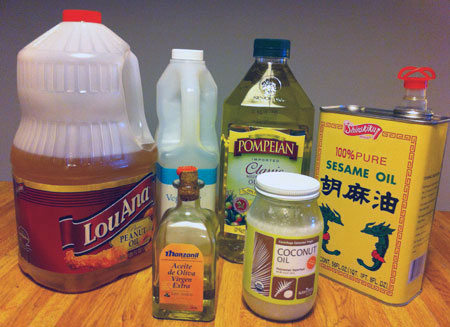The other day, my friend Summer suggested I write a post about what kind of oil to use and when. So here it is.
Science time! What’s most important about oils is how much stuff from the source plant that isn’t oil gets left behind when they’re made. Those impurities contribute flavor, but also burn when you heat up the oil. In other words, less-refined oils taste good but aren’t great for cooking, and more-refined oils have a neutral taste but can be heated to higher temperatures.
There are essentially two ways to make oil: cold-pressing and solvent extraction. Cold-pressing involves putting (olives, walnuts, whatever) under pressure in a mill to extract the oil. This conserves lots of flavor, but is expensive. In solvent extraction, you grind the (soybeans, peanuts, whatever) and dissolve the oil with a liquid solvent, typically hexane. Then you filter out the solid matter and boil off the hexane, leaving behind a very pure, flavorless, low-cost oil.
What does this all mean? You can basically put all oils into four different categories:
Refined oils for sautéing and stir-frying
These are your all-purpose, everyday cooking oils. They have a relatively high smoke point and are very cheap. Canola, soybean, corn, olive (plain ol’ olive oil, not extra-virgin), and “vegetable” oil fall into this category. To be honest, these essentially taste and act identically. But olive oil is healthiest, as it has the highest level of heart-healthy monounsaturated fats. I buy a big jug of a cheap brand of olive oil and use that for most of my cooking needs, but I also have a bottle of soybean oil on hand, as it has an almost completely neutral flavor and is better than olive oil for things like cookies and brownies. (By the way, ever wonder where canola oil comes from? Now you know.)
High-smoke-point oils for deep-frying
For the most part, you can deep-fry in any of the oils above if you’re careful. But it’s much easier if you use peanut or safflower oil, which can easily handle temperatures all the way up to the 450° some deep-fry recipes call for. Safflower oil is what many giant corporations use to fry potato chips, but I don’t think I’ve ever seen it at my grocery store. Go with peanut. And remember that you can reuse your frying oil at least two or three times—let it cool and strain through cheesecloth back into its original container. (Just don’t do this after frying fish. Ick.)
 Unrefined oils for salad dressing
Unrefined oils for salad dressing
This category includes extra-virgin olive oil and flavorful nut oils like walnut, hazelnut, and almond. They taste great, but can get really expensive. Heating them ruins their flavor, so stick to vinaigrettes and sprinkling over cooked or raw foods just before serving. Every kitchen needs one small bottle of really good extra-virgin olive oil on hand at all times; anything else is up to personal preference (or recipe requirement).
Special cases
These oils don’t really play by the rules above.
- Sesame oil is dark-colored and has a wonderful toasty flavor and aroma, but it also has a relatively high smoke point. It’s good in vinaigrettes, but you can also stir-fry with it to add a nice note in Asian dishes.
- Coconut oil is a refined oil that’s high in saturated fat, which makes it solid at room temperature. You can take advantage of this property to make homemade Magic Shell, an ice cream topping that’s liquid and pourable but hardens on contact. Many southeast Asian cuisines also use it for frying.
- Vegetable shortening is vegetable oil that’s been hydrogenated, which means its unsaturated fats have been turned into saturated fats, and it’s solid at room temperature. That solidity lets you make thin layers of fat and flour in baked goods like pie crust and biscuits, giving them a flaky texture. Many recipes combine butter and shortening—butter gives, well, buttery flavor and shortening gives flakiness.
I think that pretty much covers it. Happy frying (and sauteing, and vinaigrette-ing)!
Did I leave any oils out? Do you disagree with some of my classifications? Need more oil advice? Leave a comment below!

So there’s never really a time I should actually cook with extra virgin olive oil, like in a manner that would be heating it up? I was thinking that was case, I just needed to have it all cleared up. Thank you so much, Jason! One more thing: I have some canola (or vegetable, the label fell off a while back) oil that’s been in my cabinets FORever. Should I throw it out? Could it be rancid?
You’re not gonna ruin anything by cooking with extra-virgin, but why bother when it’s so much more expensive?
As for rancidity, if the oil is rancid, you’ll know—it’ll smell bad and taste bitter. If it’s smells fine, you can use it.
So glad you did this… I kinda get weary of seeing olive oil in every single recipe. I think it depends on flavor profile, too – like, I don’t want olive oil in most Asian things I cook. I like peanut oil or grapeseed oil for something that’s neutral with a high smoke point.
Also I am glad you hit on nut oils – some of them are so damned good – pistachio oil is incredible, pumpkin seed oil, the others you mentioned.
Here’s a chart from Harvard on oils & fats, and their mono / poly / sat profiles. http://www.health.harvard.edu/topic/fats
(This perhaps is another post… but, interesting that lard is more heart healthy for you than butter… and has no trans fat compared to vegetable shortening. Praise the Lard.)
Thank you. Good and needed post.